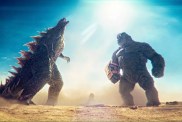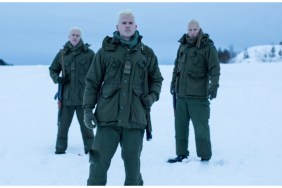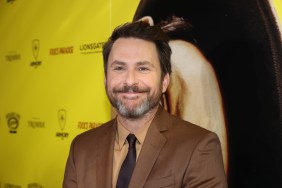Dennis Quaid as Jack Hall
Jake Gyllenhaal as Sam Hall
Emmy Rossum as Laura Chapman
Dash Mihok as Jason Evans
Jay O. Sanders as Frank Harris
Sela Ward as Dr. Lucy Hall
Austin Nichols as J.D.
Arjay Smith as Brian Parks
Tamlyn Tomita as Janet Tokada
Sasha Roiz as Parker
Ian Holm as Terry Rapson
Kenneth Welsh as Vice President Becker
Robin Wilcock as Tony
Jason Blicker as Paul
Kenneth Moskow as Bob
Tim Hamaguchi as Taka
Glenn Plummer as Luther
Adrian Lester as Simon
Richard McMillan as Dennis
Nestor Serrano as Gomez
Story:
Climatologist Jack Hall (Dennis Quaid) predicts that global warming is about to create a second Ice Age, but no one believes him until tornadoes and hailstorms and tidal waves begin wiping out major cities. Hall’s son Sam (Jake Gyllenhaal) is trapped in a flooded New York City that is about to get hit by the wave of cold, so Hall decides to trek across four states to try to rescue him.
What Worked:
There is no question that this is a Roland Emmerich movie. He has replaced the aliens of Independence Day with a timely environmental adversary in nature itself and it allows Emmerich to do what he does best, taking the deadly weather to the ultimate extreme with tons of epic destruction. Emmerich once against flexes his computerized muscles to produce some jaw-dropping visuals and effects. Seeing tornadoes rip apart Los Angeles and tidal waves ravage New York are just the icing on the cake of a movie that shows Arctic landscapes and beautiful shots from space of the earth being struck by a wave of freezing ice. Seeing the entire island of Manhattan instantly frozen as if dropped in dry ice is also pretty neat. The effects and eye candy are easily the best part of the movie; they really must be seen on a big screen.
Emmerich has a more talented cast than some of his previous movies including Dennis Quaid playing a role that isn’t much of a stretch for him, although he plays the part with conviction. On the other hand, Jake Gyllenhaal makes a great protagonist as his son Sam, turning him into a nice and likeable guy who you really want to see succeed and succeed. You can almost forgive him for some of the dumb things he does throughout the movie. His budding relationship with Emmy Rossum’s character is one of the few aspects of the story that really is warm and touching. Ian Holm is as good as always as a British weather expert, but he’s sorely underused.
The movie has a few funny gags like the movie’s main antagonist, a vice president who bears more than a passing resemblance to Dick Cheney. His presence and the way he drops the ball in the face of global disaster is worth a few chuckles. Another one involves the irony of Mexico closing its borders to stop the invasion of Americans trying to escape the coming of the Ice Age.
What Didn’t Work:
(SPOILER WARNING: Some of the movie’s specific plot points are discussed in this section.)
The Day After Tomorrow follows a typical disaster movie formula, interspersing the money shots–most of which can be seen in the trailer–with slow-moving character and story development. It’s the latter part where the movie falters as halfway through the movie, Emmerich runs out of cool weather destruction ideas and gets to the main story, about four or five groups of people trying to survive in the face of the natural disaster.
While the environmental message is a sound one, the movie is far too preachy, trying to make it seem like something like this may happen if we’re not careful. Whether or not Emmerich backed this presumption with research doesn’t matter, because the big words that Quaid and the scientists use to describe and explain what is happening will go over most heads, especially those who believe that something like this is possible.
Most of the characters are bad stereotypes and a lot of them are just plain dumb. It’s one thing for the unknown extras to walk into impending danger, but the main characters, who seem to be smarter than everyone around them, do equally dumb things. Sam rushes into a flooded basement to reach a payphone to call his father who-get this-walks from Washington, D.C. to New York City. That’s about four hours by car or train. Who knows how long it would take to walk it, let alone in the worst weather in known history? And let’s not forget, this is supposedly one of America’s most brilliant scientists. When the characters do dumb things like this, it’s very hard to root or care for them, and some of the movie is so dumb and unbelievable that it ruins any of the credibility the movie might have had up until that point.
When all else fails, Emmerich tries to make you care for these characters with overly sentimental storytelling. Introducing a young cancer patient solely to have him trapped at the hospital during the evacuation is the worst case of this, an obvious ploy to pander to the viewer’s emotions. That said, there’s not enough groundwork to establish the relationship between Quaid and his son, so it doesn’t really work.
Most of the developments are done solely to induce false peril and suspense, but anyone who’s seen any of the movie’s predecessors knows that none of the important characters will get badly hurt or killed, so it is completely ineffective. The most ridiculous subplot is done solely to get some of the guys to go out into the bitter cold where they face a bunch of rabid CGI wolves. (Don’t worry. No pixels were injured in the making of the sequence.) After fighting off the wolves and escaping a wave of blistering cold bearing down on the city, the reason for them doing so is never mentioned again, which makes it obvious how unnecessary it was in the first place. The subplot with Ian Holm and the guys at the British weather station is also conveniently forgotten.
The ending makes even less sense, and it is equally ridiculous. (Scroll mouse over blank section to read the spoiler.)
The scientists and political types spend most of the movie saying how there’s nothing they can do stop the disaster, so when the deadly wave of freezing cold sweeping across the north mysteriously dissipates on its own, it’s an anti-climax. With no one doing anything to stop the destruction or save lives, there are no real heroes in the movie and trying to create a hopeful ending from the fact that a half dozen people survived in a city of millions is inane. You can’t see this destruction and imagine that the world could ever be the same again, unlike the ending of Independence Day.
If the story and its message didn’t make the movie seem any more like a bad television movie-the writing is even worse. It is soap opera bad, and even the strong actors can barely pull off some of the cheesy dialogue.
There seems to be little point to the Los Angeles twister sequence, since the city has absolutely no importance to the story. Although that sequence has some of the movie’s best money shots, it is completely gratuitous and it makes little sense once it’s established that Hollywood is well south of the weather “safe zone”.
The Bottom Line:
The Day After Tomorrow is the kind of formulaic disaster movie that audiences would have eaten up in the 70’s and 90’s, but it’s hard to believe that this sort of movie is still being made in this day and age. Those who missed Armageddon, Deep Impact, Twister and Volcano and those who forgot how bad those movies were will probably rush out to see The Day After Tomorrow. While the premise is worthwhile and the special effects are excellent, the unbelievable story and cheesy writing are worse than any of those other movies, and the rest of it rehashes ground that has already been covered. Ultimately, this is just a dumb movie about dumb people doing dumb things that people will go see anyway.
The Day After Tomorrow opens everywhere on Friday.










